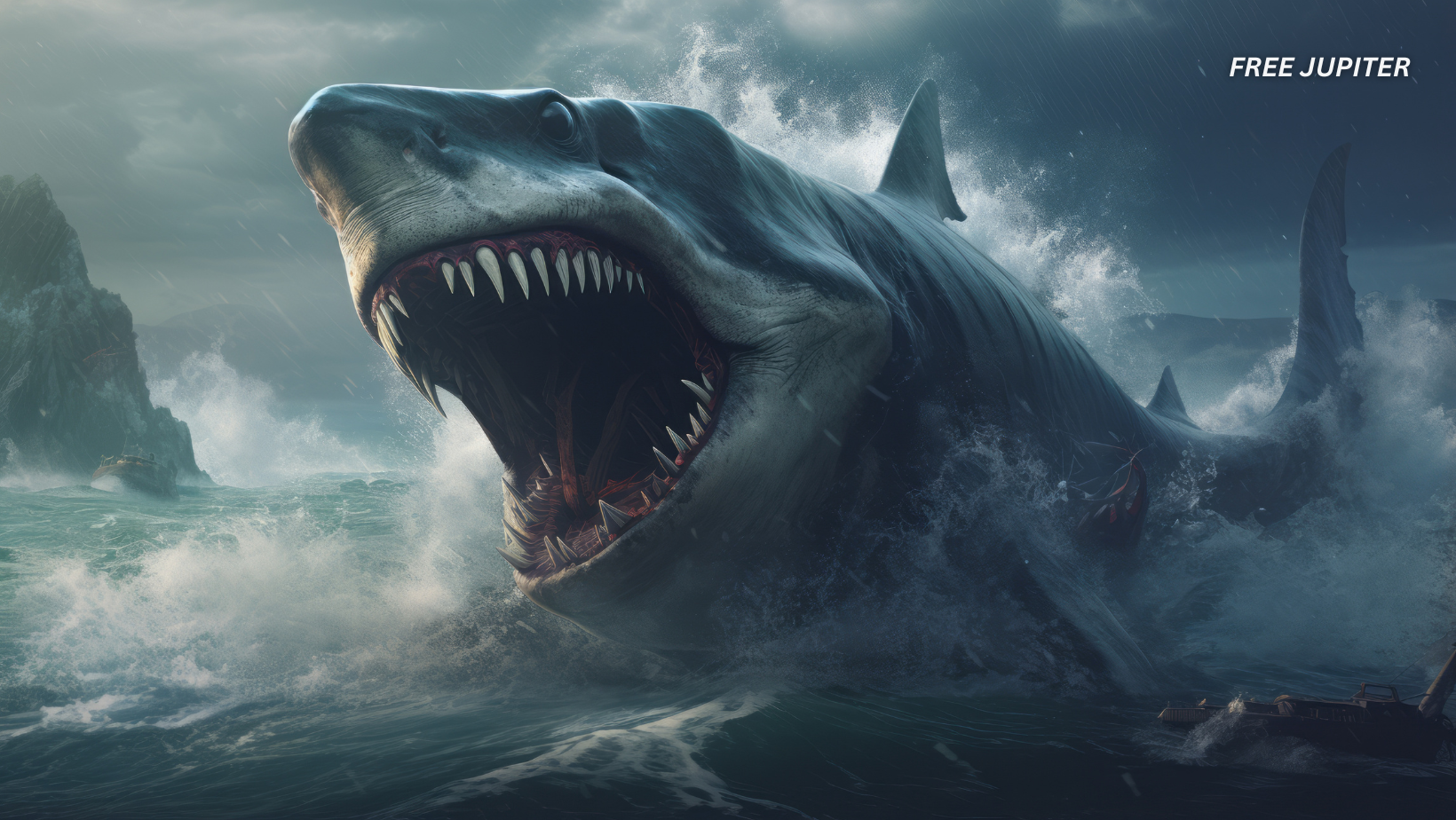Friendly Note: FreeJupiter.com shares general info for curious minds 🌟 Please fact-check all claims—and always check health matters with a professional 💙
The megalodon—whose very name evokes images of massive teeth and insatiable hunger—may have been a far more flexible feeder than scientists originally assumed. Long painted as the apex predator of the prehistoric seas, this behemoth of a shark likely followed its stomach more than a strict menu of whales.
A recent scientific study challenges our long-held notions about this ocean giant. While the megalodon certainly had the power to bring down whales, its fossilized teeth reveal a more opportunistic approach to dining. This ancient predator, which ruled the seas until its extinction around 3.6 million years ago, appears to have devoured whatever was available—including prey much smaller than itself.
Shifting the Megalodon’s Dietary Narrative
Jeremy McCormack, a geoscientist from Goethe University in Frankfurt and lead author of the study, notes that the megalodon was probably less picky than we once believed. “If a large meal was around, great. If not, it was capable of settling for smaller creatures,” McCormack explained.
The findings, published in Earth and Planetary Science Letters, shine light on a previously underappreciated side of megalodon behavior. Instead of a relentless hunter of whales alone, the megalodon may have roamed the seas consuming a wide range of creatures—from top-tier marine predators to smaller, more accessible swimmers.
“They were clearly at the top of the food chain,” said McCormack. “But they also seemed willing to dip lower into the hierarchy when necessary.”
Bite First, Ask Later
With teeth that stretched up to 7 inches long—roughly the length of a human hand—the megalodon didn’t need subtlety. Its bite was brutal, and its dentition serrated, making it an efficient hunter. These teeth are often the only remnants we find of the creature, since sharks, being mostly cartilage, leave little else behind in the fossil record.
These fossilized teeth, however, hold more than just terrifying visuals. McCormack’s team performed geochemical tests on them, looking for one crucial clue: zinc.
Zinc and the Secrets of Prehistoric Appetites
Zinc is an essential nutrient that all living creatures acquire through their food. In sharks, it becomes embedded in the enamel of their teeth. Crucially, the type—or isotope—of zinc present can offer clues about an animal’s place in the food web.
Here’s how it works: animals at the bottom of the food chain have more of a heavy isotope known as zinc-66, while those higher up show lower levels due to how zinc is processed in the body. When researchers measured the zinc isotopes in megalodon teeth and compared them to the teeth of other ancient and modern marine predators, they found surprising results.
Rather than being chemically distinct from animals lower on the food chain, the megalodon’s teeth bore zinc signatures suggesting that it sometimes consumed prey far below it in the marine hierarchy.
In essence, the mighty megalodon may have gobbled up everything from small sharks and fish to massive whales, depending on what swam within reach.
The Ocean’s Buffet Table
The reconstructed food web built from the zinc analysis placed sea bream—known for snacking on crustaceans—at the base. Above them were medium-sized sharks, followed by extinct toothed whales, comparable in size to dolphins. Even higher were tiger shark-like predators, culminating with megalodon at the top.
However, the differences between these levels weren’t as dramatic as expected. This suggests the megalodon wasn’t feasting exclusively on marine giants. “It could dine at the top but didn’t mind slumming it with smaller fare,” McCormack summarized.
Read more: Study Finds Popular Blood Pressure Medication Extends Lifespan and Slows Aging in Animal Models
Not a Lone King, After All
Perhaps more surprising was the realization that the megalodon didn’t have exclusive rights to the ocean’s top predator spot. The study revealed that other giant sharks—such as the Otodus chubutensis and Araloselachus cuspidatus—also shared apex status.
This raises an intriguing idea: megalodon may have had competition. And one of those contenders may have even played a role in its eventual extinction.
Enter the great white shark.
When Smaller Was Smarter
According to paleobiologist Kenshu Shimada, one of the study’s coauthors, the great white’s emergence may have marked the beginning of the end for the megalodon.
Unlike megalodon, great whites grow into their diet. They start with fish and graduate to marine mammals as they mature. This adaptability, coupled with a smaller, more agile build, might have made them better suited for changing marine ecosystems.
Shimada emphasized the importance of dietary overlap: “If both sharks were targeting similar food sources, the great white may have outcompeted the megashark.”
This isn’t mere speculation. The study’s zinc analysis supports the idea that both sharks had similar diets. When resources are limited, having a smaller body and sharper maneuverability can be key advantages.
A Snapshot of Ancient Seas
Jack Cooper, a UK-based paleobiologist who wasn’t involved in the study, praised the findings. “We tend to picture megalodon as this giant whale-eater,” he wrote, “but it turns out it probably had a diverse diet—pretty much anything that looked edible.”
Cooper also found the regional dietary differences fascinating. Populations of megalodon living in different parts of the world likely tailored their diets to local prey. “That’s something we also observe in great whites today,” he added. “It makes perfect sense.”
Such variability reinforces the image of megalodon as a dynamic, resourceful predator. It wasn’t just brute force that made it king of the seas—it was flexibility.
More Than a Giant White Shark
Alberto Collareta of the University of Pisa believes studies like this help redefine our understanding of megatooth sharks. “For a long time, we’ve treated them as oversized great whites,” he said, “but they were unique in many ways.”
The recent discoveries suggest that while prehistoric ecosystems were filled with creatures that seem alien today, they operated in ways surprisingly similar to our modern oceans.
Still, Collareta noted that much of what we know comes from teeth. “We’re working from fragments,” he remarked. “What we really need is a complete skeleton to better grasp what this creature was truly like.”
Until that fossil miracle emerges, teeth will remain the megashark’s most eloquent messengers.
Read more: A New Shape-Shifting ‘Flapjack’ Octopus Has Been Discovered in the Deep Sea Near Australia
Rethinking the Megalodon Mythos
The traditional narrative has often cast megalodon as a singular terror of the seas, a monster that dined only on whales and swam uncontested. But mounting evidence paints a more nuanced picture: one of a powerful, adaptable predator that fed across the food web and shared the oceans with rivals.
While its size remains a subject of debate—ranging anywhere from 52 feet to as much as 80—the megalodon’s story is far from fossilized. With each tooth analyzed, researchers are slowly piecing together a more complete portrait of this long-extinct giant.
In the end, the image of a hyper-specialized whale-slayer gives way to something more real—and perhaps more impressive. A shark that could devour a dolphin or a tuna with equal ease, a beast that adjusted to its environment, and one that—despite its dominance—was not invincible.










